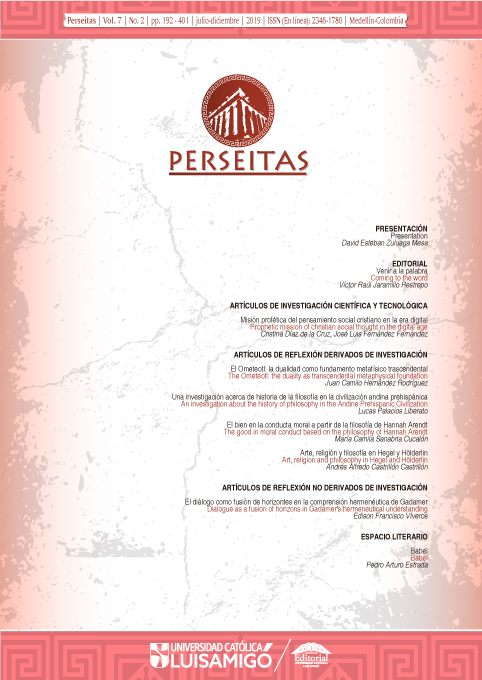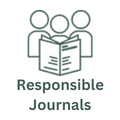Arte, religión y filosofía en Hegel y Hölderlin
DOI:
https://doi.org/10.21501/23461780.3294Palabras clave:
Arte, Religión, Filosofía, Hegel, HölderlinResumen
El artículo tiene como propósito dilucidar las nociones de arte, religión y filosofía que expone el filósofo Hegel en su obra Enciclopedia de las ciencias filosóficas y en las Lecciones sobre la estética y la que expone el escritor Friedrich Hölderlin en su novela Hiperión o el eremita en Grecia. La finalidad del escrito es contrastar ambas posturas y analizar la interpretación que hace Hegel del arte. Ambos autores conciben dicha triada como una manifestación y exteriorización de la producción y devenir espiritual de los pueblos. Hölderlin le otorga al arte una vigencia y vitalidad para intervenir en la construcción de la sociedad moderna a nivel religioso y político, pero Hegel considera que la filosofía, que supera y conserva al arte y a la religión, tiene la prioridad en la modernidad en tanto posibilita la comprensión y el progreso del momento vigente. El texto concluye indicando las diferencias entre estas dos posturas.
Descargas
Referencias
Béguin, A. (1994). El alma romántica y el sueño. Colombia: FCE. Primera reimpresión.
Blanchot, M. (2002). El espacio literario. Madrid: Editorial Nacional.
“Hegel y la religión”. (2008). En: Díaz, A., Acosta, M. del R. (ed.) La nostalgia de lo absoluto: pensar a Hegel hoy. Recuperado de https://www.academia.edu/415551/La_nostalgia_de_lo_absoluto_pensar_a_Hegel_hoy
Domínguez, J. (2008). Arte como formelle Bindung en el mundo moderno en la estética de Hegel. En: Estudios de filosofía. No. 37, 201-221.
Dudley, W. (2009). Hegel, Nietzsche, and philosophy. Thinking freedom. Cambridge: Cambridge University Press.
Ginzo Fernández, Ar. (1996). Política, religión y filosofía en G. W. F. Hegel. En: Revista de estudios políticos (Nueva Época). No. 94, 111-145.
Hegel, G.W.F. (2017). Enciclopedia de las ciencias filosóficas. Madrid: Abada.
Hegel, G.W.F. (2011). Lecciones sobre la estética. Madrid: Akal.
Hegel, G.W.F. (2006). Filosofía del arte o estética. Madrid: Abada.
Hölderlin, F. (1989). Hiperión. Versiones previas. Madrid: Hiperión.
Hölderlin, F. (2002). Hiperión o el eremita en Grecia. Madrid: Hiperión.
Hölderlin, F. (1990). Correspondencia completa. Madrid: Hiperión.
Kreuzer, J. (2011). Hölderlin Handbuch. Leben. Werk. Wirkung. Stuttgart Weimar: Verlag J.B Metzler.
Mas, S. (1999). Hölderlin y los griegos. Madrid: La balsa de la Medusa.
Másmela, C. (2018). Hölderlin. La intimidad del medio hespérico. Medellín: Universidad de Antioquia.
Pinkard, T. (2002). Hegel. Una biografía. Madrid: Acento.
Reotzer, H. G. (2012). Historia de la literatura en lengua alemana. Desde los inicios hasta la actualidad. Barcelona: Universidad de Barcelona.
Safranski, R. (2012). El romanticismo. Una odisea del espíritu alemán. Barcelona: Tusquets.
Schiller, J.C.F. (1990). Kallias. Cartas sobre la educación estética del hombre. Barcelona: Anthropos.
Wallerstein, I. (2011). El moderno sistema mundial. La segunda era de la gran expansión de la economía-mundo capitalista, 173-1850. México: Siglo XXI.
Publicado
Cómo citar
Número
Sección
Licencia
Derechos de autor 2019 Perseitas

Esta obra está bajo una licencia internacional Creative Commons Atribución-NoComercial-SinDerivadas 4.0.
La revista y los textos individuales que en esta se divulgan están protegidos por las leyes de copyright y por los términos y condiciones de la Licencia Creative Commons Atribución-No Comercial-Sin Derivar 4.0 Internacional.

















